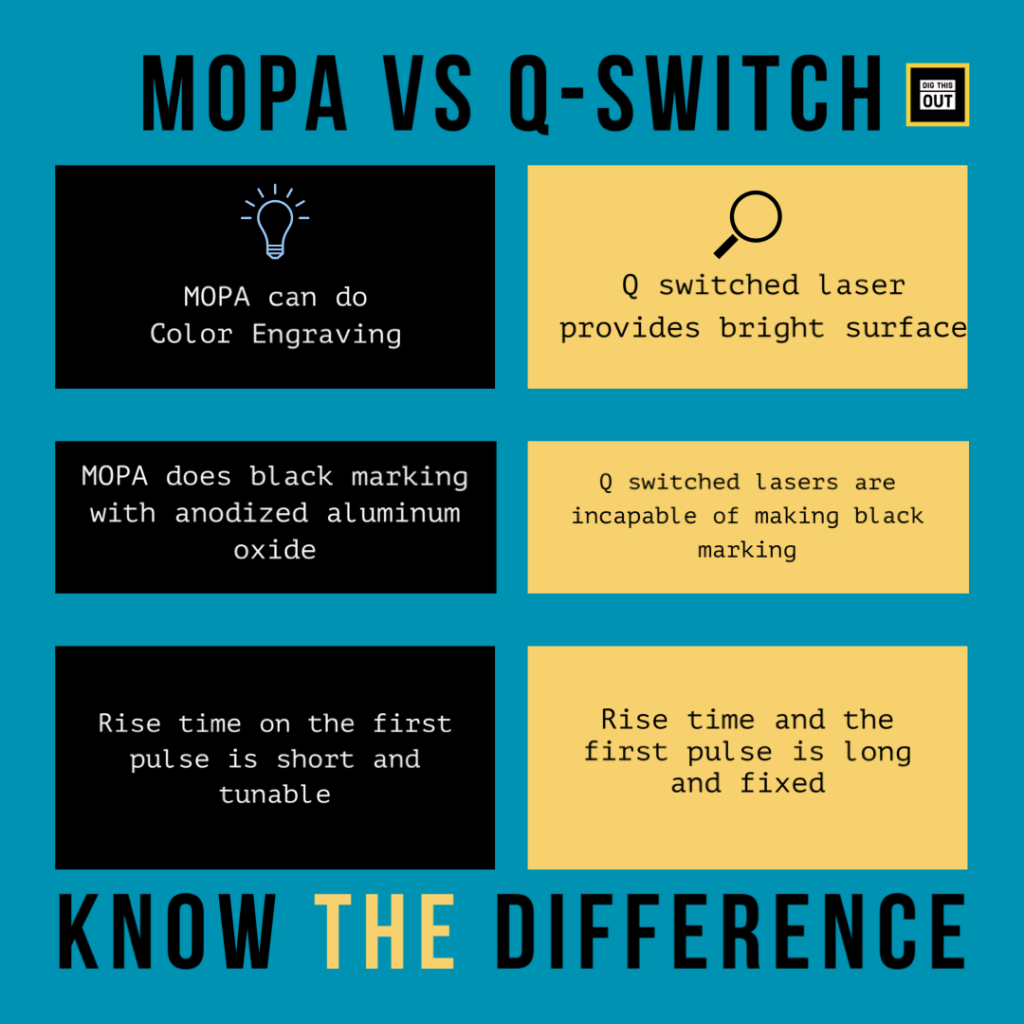MOPA (Master Oscillator Power Amplifier) fiber laser is becoming so popular due to the ability of color engraving & stainless steel marking.
MOPA fiber laser is capable of producing higher power output than other types of fiber lasers. It consists of two parts, the master oscillator, and the power amplifier. The master oscillator is the device that generates the initial optical pulse, which is then amplified by the power amplifier. The amplified pulse is then passed through the laser cavity to create the desired output power.
The main advantage of MOPA fiber laser is that it can produce higher output power than other types of fiber lasers. This is due to the fact that the power amplifier can be configured to achieve a high gain and thus amplify the pulse to the desired power level. In addition, the master oscillator can be tuned to produce a narrow–linewidth output. This allows for more precise control of the output power and the ability to produce higher power levels than other types of lasers.
Besides, MOPA fiber laser is also capable of producing higher pulse energies than other types of lasers. This is due to the fact that the power amplifier can be configured to maintain a high gain over a wide range of pulse energies. This allows for more efficient use of energy and thus more power output from the laser.
What are the main advantages of MOPA fiber laser?
MOPA fiber laser also has a number of other advantages. For example, it can be used to produce extremely short pulses. This is due to the fact that the power amplifier can be configured to achieve a high gain over a wide range of pulse energies and durations. Additionally, the master oscillator can be tuned to produce a narrow–linewidth output. This allows for more precise control of the output power and the ability to produce higher power levels than other types of lasers.

It is also highly reliable and efficient. This is due to the fact that the power amplifier can be configured to achieve a high gain over a wide range of pulse energies and durations. This ensures that the laser can produce consistent output power over time.
Additionally, the master oscillator can be tuned to produce a narrow-linewidth output. This ensures that the output power is more stable and consistent over time.
Precisely, MOPA is capable of producing higher output power than other types of lasers. It is capable of producing extremely short pulses and can be tuned to produce a narrow–linewidth output. Furthermore, it is highly reliable and efficient and can be used to produce consistent output power over time.
So, the advantages of the MOPA laser are:
- Superior laser beam quality than the CO2 & other fiber lasers
- Air cooling operating capacity
- Low power consumption
- Diodes have longer lifespans (usually more than 10 thousand hours)
- Allows flexible laser marking even without deforming the material
- Power and pulse width are tunable as needed
How does MOPA fiber Laser work?
Here’s how the MOPA fiber laser functions:
- Initially, the master laser (alternatively known as the oscillator) generates the laser beam.
- Then the optical power amplifier magnifies the laser power.
- The amplified laser power is then forwarded to the mirror galvanometer which delivers the final laser power for engraving & marking.

What can you do with MOPA Laser?
The application of MOPA fiber laser is straightforward. The users of a MOPA laser do color engraving on metal, especially marking in anodized aluminum. Apart from black marking on aluminum, you can engrave roughly 16 colors on stainless steel with a MOPA laser.
Furthermore, with a MOPA laser you can always do marking in plastics only because this laser can have proper control over highly sensitive materials.
MOPA laser alters the laser parameters so that the beam is able to produce a higher amount of heat during the engraving process. This heat is then able to penetrate deeper into the material and create a color change. Depending on the material, colors such as black, blue, green, and red can be achieved.
Here’s an example of laser marking done with a MOPA laser by our experts:

Besides, using a MOPA laser at high power and low-speed creates a deep and black mark on the surface of the aluminum. The laser should be set to a pulse duration of around 50-100 microseconds and a frequency of around 10 kHz. The power settings should be adjusted accordingly to create a deep, dark mark. Additionally, a lower frequency (around 1-2 kHz) may be used to reduce the heat-affected zone and create a higher contrast mark.
Also, MOPA laser uses pulsed laser source which heats and ablates the plastic and creates amazing color marks without even destroying the material components. However, the control of laser here is important if you need a proper marking on plastic without any harm.
Here’s another laser marking example on Anodized Aluminium with a MOPA fiber laser:

What are the suitable materials for a MOPA laser?
We already know that heat-sensitive materials such as fabric and leather would require a CO2 laser for better cutting & engraving. You may also use the diode lasers to cut & engrave materials such as wood acrylic. A diode laser would also offer you engrave coated stainless steel with no complexities.
However, if you need color engravings & marking, MOPA is the ideal choice, and here is the list of compatible materials.
For black engraving, you may use aluminum. For the color engravings, stainless steel, nickel, carbon steel, and iron would be suitable. However, you can also place other materials such as Gold, Titanium, Silver, and plastics under a MOPA fiber head for the sharpest marking and engravings.
MOPA fiber Vs Q-Switched fiber laser
Both MOPA and the Q Switched lasers are fiber laser types. Here is a quick comparison that will enable you to understand the difference between both at a glance.

If you want to engrave lightweight materials such as a smartphone back cover or a keyboard key, the Q-switched fiber laser may deform the material for its heavy heat transformation and generation of smaller convex bulges.
A MOPA fiber laser uses ultra-short pulses that help protect the thin materials from deforming & gives a vibrant marking or engravings.
Engraving or, black marking aluminum (such as iPhone / iPad’s logo) cannot be done with a Q-switched fiber laser because only the MOPA lasers use high frequency and narrow pulse width which perfectly creates marking on thin aluminum.
For metal engraving, a Q-switched fiber use produces a coarse group whereas the MOPA laser creates fine grooves.
A MOPA laser is also efficient in creating thin and precise lining of electronics and ITO precision machining whereas the Q-Switched fiber laser is completely unable to generate thin lining which also leaves a yellow mark after engraving because the Q-switched laser’s pulse width is too high along with the high pulse energy.
Here’s a comparison summary of the MOPA fiber laser & Q-Switched fiber laser:
| Factors | Q Switched Fiber Laser | MOPA Fiber Laser |
| Laser Modulation | Q Switching | Electrical Modulated Seed |
| Pulse Shape | Fixed | Modified by seed modulator |
| Pulse Width | Fixed | Tunable |
| Power | Fixed | Tunable |
| Pulse repetition rate | 20-80 kHz | 1-4000 kHz |
| Rise time of first pulse | Long, & Fixed | Short & Tunable |
| Color Engraving | Unable | Available |
| Engraving Thin Material | Unable | Available |
Final Thought
Both MOPA fiber lasers and Q-Switched fiber lasers are specialized for two different purposes. Undoubtedly the MOPA fiber lasers are the great invention of the laser engraving era.
Here’s a video on how MOPA laser is doing different marking activities:
